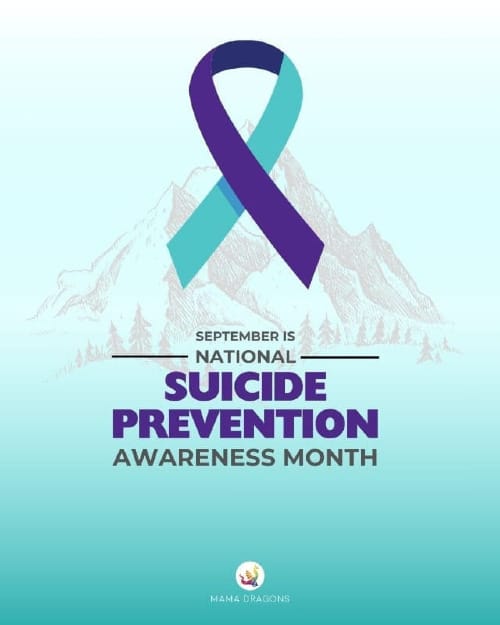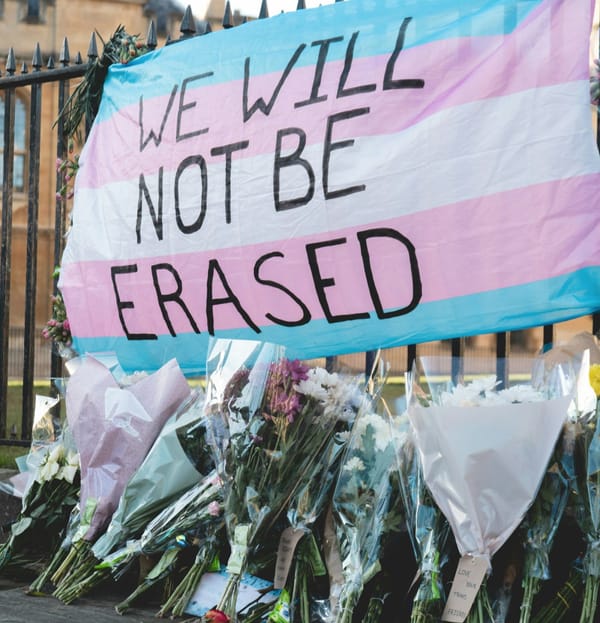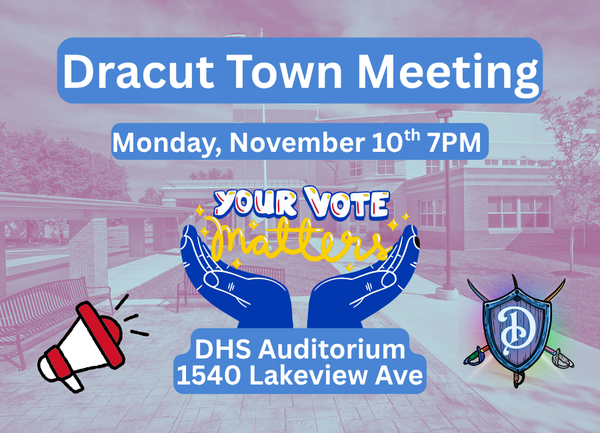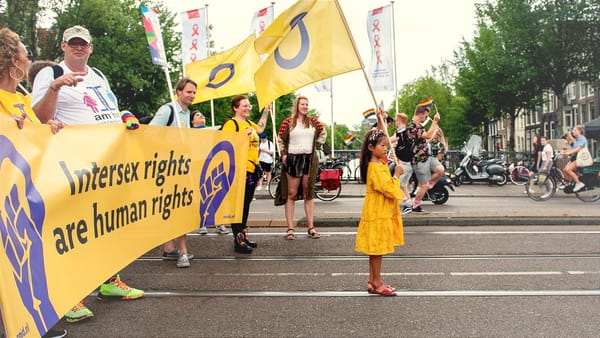September is for Suicide Prevention
Mental health matters. Suicide prevention starts with individual understanding & continues through community care.
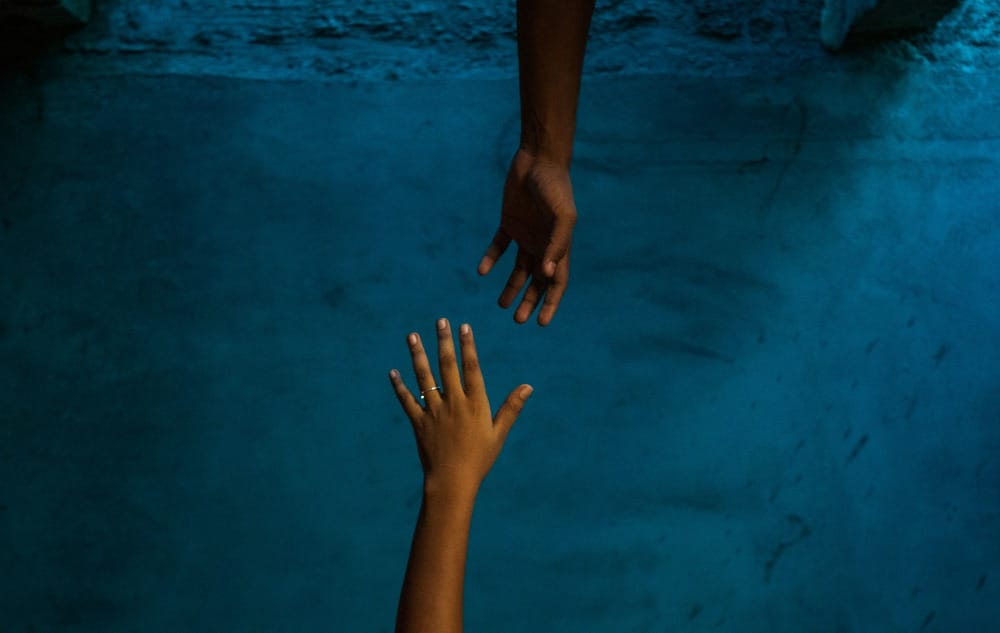
It's September already! Schools are back in session, every coffee place is swimming in pumpkin spice, & a promise of cooler air and colored leaves hangs on the horizon. The month of September is also officially recognized as national suicide prevention awareness month. It's an emotionally charged topic, of course, but one that's vital to speak on. Eroding the stigma around mental health & suicide helps us move forward towards a place of acceptance, awareness, and action that helps save lives.
I myself have dealt with depression, anxiety, & self-harm for the better part of my life. Through supportive parents, therapy, doctor prescribed medications, and compassionate companions, I'm able to live my life in a way that is affirming and whole. Even so, the stresses of life can create uncomfortable hurdles at times. I can attest to how chronic depression can consume one's life; it inserts itself into one's own thoughts, unwelcome. Know that you are never alone, and there are lots of support networks out there that want you to reach out for help.
First, let's understand the context of suicide prevention in the U.S. today. Then, we will see how the LGBT+ community is affected by suicide before going into how to support someone who may be struggling. Finally, we'll see what resources are available for those suffering with suicidality as well as those wanting to help their own loved ones through a mental health crisis.
American Foundation for Suicide Prevention—
Statistics from Centers for Disease Control and Prevention (CDC) Data & Statistics Fatal Injury Report for 2023
- Suicide is the 11th leading cause of death in the U.S.
- The overall age-adjusted suicide rate in the United States remained nearly the same, at 14.21 per 100,000 in 2022 and 14.12 per 100,000 in 2023.
- In 2023, the CDC estimates that approximately 1.5 million Americans attempted suicide, and 49, 316 Americans died by suicide.
- In 2023, men* died by suicide 3.8 times more than women*.
- White men accounted for 68.13% of recorded suicide deaths in 2023.
- In 2023, firearms accounted for 55.36% of all suicide deaths.
- 91% of adults surveyed in the U.S. think suicide can be prevented at least some of the time.
*These terms are used to indicate sex assigned at birth in accordance with the CDC study, rather than an indication of gender identity.
Video from the American Foundation for Suicide Prevention
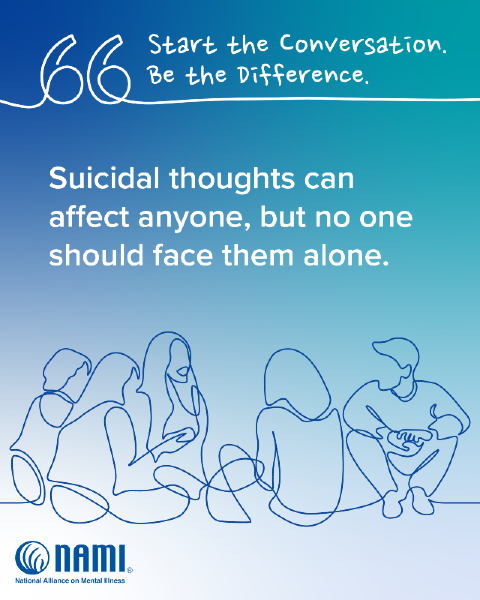
Our Words Matter
One of the barriers to getting proper care for anyone struggling with suicidal thoughts or ideation is stigma. Self-harm and suicide are often taboo topics, and the language we use around those actions can unwittingly contribute to that.
A common term used when someone dies by suicide is that they "committed suicide" or, if someone survives a suicide attempt, they had a "failed suicide attempt." Each of these phrases stigmatizes suicide in different ways. First: "commit" implies suicide is either a sin or a crime & frames the action as a selfish, personal choice, rather than a tragedy brought on by mental illness. The idea of framing any suicide attempt as "successful" or "failed" is deeply inappropriate and flawed, as it establishes a tragic outcome as an achievement or something positive.
According to the recommendations made by the Canadian Psychiatric Associations' Media Guidelines for Reporting on Suicide, better language to use around suicide would be plain language that doesn't come with value judgements baked in. Should someone die by suicide, simply say that, or that they lost their life to suicide. When discussing attempts, specify only if it was fatal or non-fatal (which is the only fact of importance around a suicide attempt). Additionally, it's best not to define any one person as "[Name] is suicidal" as no one wants to be defined by that experience; rather, stating that "[Name] is facing suicide/experiencing suicidal thoughts" communicates an individual's struggles while not defining them by their mental illness.
Language around suicide isn't about policing vocabulary but reducing stigma. The more we're able to speak honestly about suicide, the more chances that someone struggling can reach out and get the support they need without fear of isolation, ostracization, or judgement.

Suicide Prevention in the LGBTQ+ Community
When it comes to the LGBTQIA2S+ community specifically, suicide rates are generally much higher than the majority cisgendered, heterosexual population. According to the Massachusetts Transgender Political Coalition, a 2015 U.S. Trans Survey by the National Center for Transgender Equality demonstrated that "40% of trans individuals have attempted suicide at some point in their life, compared to 4.6% in the U.S. population." The primary causes of this are social stigma, lack of access to healthcare, absent familial support, poor community care, and targeted harassment & bullying. Depending on the intersections of one's identity, the mental health challenges increase: trans & genderqueer people of color have the greatest risk of suicidal thoughts, impulses, and ideation due to the layers of stigma & discrimination based on various overlaying marginalized identities.
Being transgender doesn't have an innately higher rate of suicidality—it's the social stigmas, discrimination, community isolation, & vilification of queerness that contribute to the mental health struggles faced by trans & genderqueer folks.
"The [2023] report [The Trevor Project’s 2023 National Survey on the Mental Health of LGBTQ Young People] found that 36% of LGBTQ+ youth from 13-24 believed they had a low chance of living to age 35. This rate was even higher for LGBTQ+ people who experience minority stress — a unique form of distress experienced by marginalized groups — like trans youth, youth of color, and multisex teens. According to the report, young people who had reported having a suicide attempt in the last year were also more likely to report a low sense of life purpose and were less likely to believe they would [live] past age 35.
The findings paint a picture of how many LGBTQ+ do not believe they will live long, full-filled lives, and point to systemic factors making their long-term survival seem unimaginable. From waves of anti-LGBTQ+ legislation to the onslaught of violence against trans people of color, our youth are enduring more and more stress."
-Over a Third of LGBTQ+ Youth Do Not Believe They Will Live Past 35 by Quispe López (January 31, 2024)
2011 video uploaded by the Massachusetts Transgender Political Coalition
The current attacks on trans healthcare coordinated by the federal government aren't helping with the mental health crisis among queer folks. With growing anti-trans rhetoric and legislation, as well as bullying & intimidation tactics used against clinics, doctors, & hospitals that provide life-saving, gender-affirming care, it can be especially despair-inducing to be trans today.
Then, of course, we must also mention the deeply cruel shuttering of the national LGBT+ suicide prevention hotline—the "Press 3" option available via the 988 crisis hotline, similar to the specialized branching service options available to veterans, another high-risk group for suicide—even amidst the ongoing mental health crisis trans & queer folks face.
"When we created the 988 hotline, we knew it was important that those calls, all of them, be answered promptly," says Sen. Tammy Baldwin, D-Wis., who wrote the bipartisan legislation that created 988. "Somebody in a mental health crisis, somebody contemplating suicide can't be put on hold. And so the department always had the leeway to move around resources in a way to make sure that these calls were answered in a timely and responsible way."
Ending the services for LGBTQ+ youth is a political move, says Baldwin.
"They have had relentless attacks on members of the LGBTQ community, particularly transgender individuals, transgender youth," she says. "In the face of those relentless political attacks on this very vulnerable community, to then cut off a lifeline is absolutely cruel."
-"Trump administration ends 988 Lifeline's special service for LGBTQ+ young people" by Rhitu Chatterjee of NPR (19 July 2025)
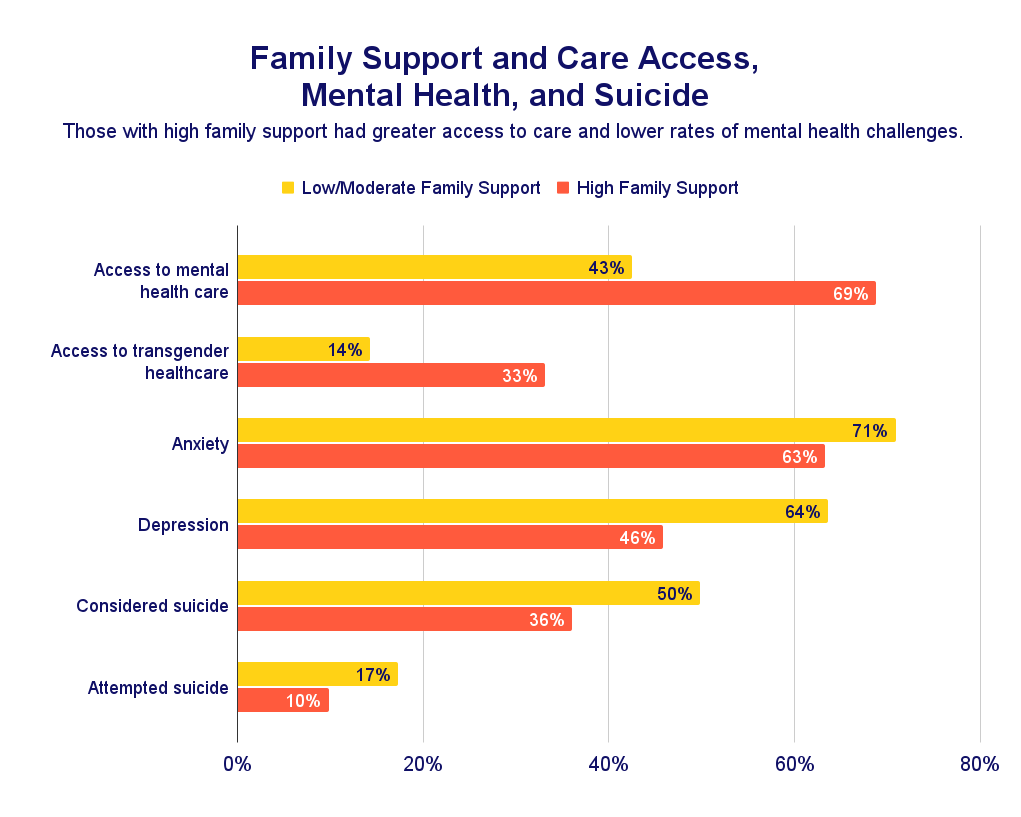
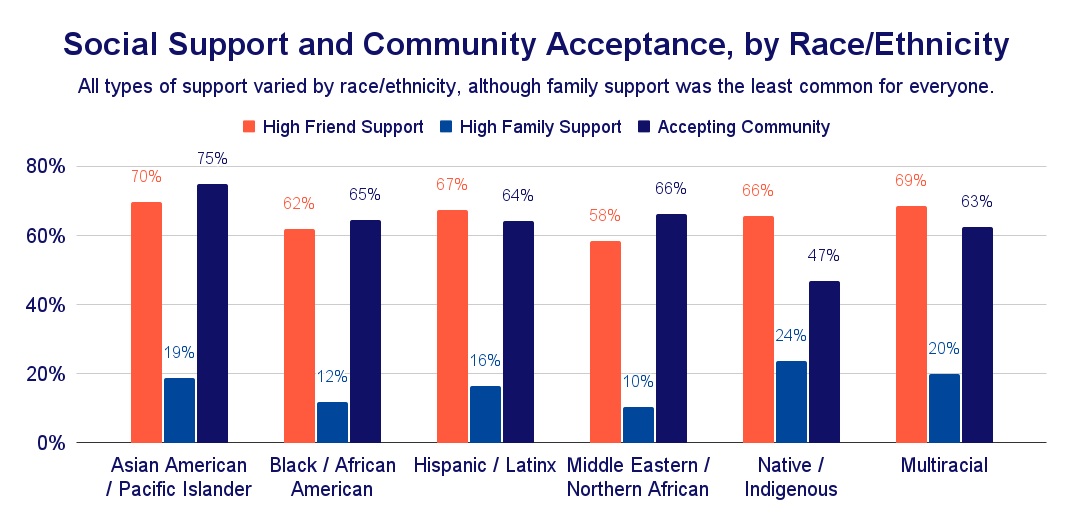
Statistics & Graphics from Friends, Family, and Community: Social Support and the Health of Transgender and Nonbinary Young People of Color (2025) by The Trevor Project
The Trevor Project studies show 39% of LGBTQ+ young people in Massachusetts considered suicide in the past year, and 11% admitted to attempting suicide. A monthly average of 580 callers in Massachusetts pressed “3” to choose the dedicated support line last year.
“Young people are going to die because of this,” said Sean Cahill, Director of Health Policy and Research at Fenway Institute. “It’s devastating.” Fenway Health in Boston provides care to 35,000 patients, and about half of them identify as LGBTQ, including youth patients.
“We have data from our State Department of Public Health that shows 23 percent of high school students in Massachusetts either identify as LGBT or are questioning their identity,” said Cahill.
Congressman Seth Moulton is not mincing words about the discontinuation of LGBTQ-specific support for youth on the 988 hotline he sponsored the creation of.
“Apparently, they care more about making a political point, aggressively asserting their anti-LGBTQ ideology rather than saving American lives,” Moulton told Boston 25 News. “Right now, the Trump administration is on a rampage.”
According to the Trevor Project, 1.3 million LGBTQ+ children have called the dedicated number since its inception three years ago.
“I already, in many ways, am beginning to mourn the loss of lives that we know we will see because of this cut,” said Mason Dunn, a trans advocate and educator in Massachusetts. “The trend of eliminating LGBTQ+ visibility is an alarming and dangerous trend.”
— "Mass. advocates decry elimination of LGBTQ suicide prev. hotline" by Drew Karedes of Boston 25 News (July 17, 2025)
Despite the ongoing horrors of the world, always remember: there are countless people at all times of the day working to protect & uplift gender diverse youth, their families, and all members of the LGBTQIA+ community. There are numerous organizations dedicated to serving and honoring those of us who are gay, lesbian, multisexual, trans, nonbinary, and/or queer.
Boston Children's Hospital is one such institution that refutes the anti-science rhetoric enshrined in anti-trans legislation & talking points. They refuse to let transgender youth suffer needlessly.
Boston Children’s Hospital has reaffirmed its commitment to providing gender-affirming care for trans youth and says it won’t give in to bullying by the current administration.
“Boston Children’s Hospital has always been and always will be committed to providing the best care for ALL of our patients, regardless of their gender identity,” reads a statement on the website of the hospital’s Gender Multispeciality Service (GeMS) program. “The belief that all children deserve the opportunity to live, grow and thrive with love and support, is foundational to who we are and what we do.”
The statement said the hospital is “proud” that GeMS is the country’s first pediatric and adolescent trans health program.
“We believe in a gender-affirmative model of care, which supports transgender and gender diverse youth in the gender in which they identify,” it continued. “This is a standard of care grounded in scientific evidence, demonstrating its benefits to the health and well-being of transgender and gender diverse youth. In addition to supporting our patients and families, we stand with our colleagues who may identify as transgender or gender diverse, those who provide care to transgender youth and who are allies to the transgender community.”
-"Boston Children's Hospital Says it Won't be Bullied into Abandoning Trans Youth" by Molly Sprayregen of LGBTQ Nation (July 28, 2025)
I will repeat the following ad nauseam beyond the end of time:
Gender affirming is life-saving.
Trans healthcare is suicide prevention.

How can we support LGBTQ+ mental health?
The good news is that we know quite a few things about how to bolster the wellbeing of queer youth & our LGBT+ community at large, Much of it comes down to acceptance, support, & validation. Queer youth have vastly improved mental health outcomes when they receive the support they need from their families, friends, schools, & neighbors.
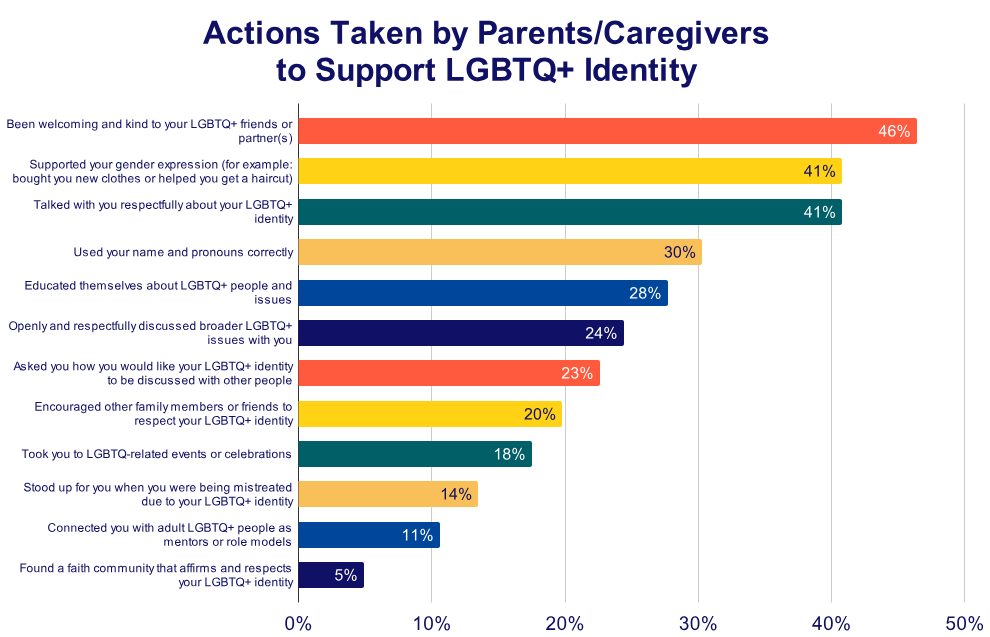
By improving the welcome & acceptance of LGBTQIA+ folks in our homes, neighborhoods, & communities, we are actively cultivating a space of mental wellness and queer youth suicide prevention. These efforts would help not only LGBT members, but everyone, as all benefit from a place of kindness & understanding.
Some ways to be an active ally in your community:
- Use stickers, signs, shirts, buttons, etcetera, to be visible with your support. A quiet, invisible ally isn't the kind of ally we need right now. We need allies that will stand strong with the LGBTQ+ community--and many of us can't choose to be invisible.
- Ask for folks' pronouns when you formally meet them. When everyone is asked the question, it helps normalize the process of learning people's pronouns and resists the currently ingrained urge to assume another's gender based on their appearance alone.
- Actively use a trans person's name & allow yourself to forget their deadname. Practice using that person's name & pronouns, either in your ahead or aloud when alone. New pronouns & names can be tricky, but they're vital to affirming a trans or genderqueer identity. The small effort is well worth it, especially considering how much this act can approve someone's mental health!
- Be sure your schools are inclusive and your curriculum welcoming to gender expansive students. Attend your local school committee meetings. Keep tabs on the publicly available minutes of selectmen meetings. Vote in town meetings & local elections. Local politics create the foundation of our communities, and the ripple effects from small towns to the nation at large grow in size a la the butterfly effect.
- Call out homophobic or transphobic rhetoric from local officials, businesses, etcetera. Then, call in your neighbors to learn better, more respectful ways to talk about and discuss the LGBTQIA+ community and our queer members.
- Familiarize yourself with local resources that you could recommend to someone struggling with their mental health. This can be accepting, affirming therapists familiar with things like gender dysphoria or queer life experiences or school guidance counselors looking to be there for their students. Or, simply be the person someone can talk to. Listening and then thoughtfully responding in kind can be just as effective (and a lot more accessible) than psychotherapy at times.
We’re here for you. Get immediate crisis support. Connect to a crisis counselor 24/7, 365 days a year, from anywhere in the U.S. via text, chat, or phone. Our trained counselors understand the challenges LGBTQ+ young people face. The Trevor Project is 100% confidential and 100% free.
Talk Saves Lives: An Introduction to Suicide Prevention in the LGBTQ+ Community
What can I do if someone I know is thinking of suicide?
If someone you know may be thinking of suicide, it can be a daunting task to approach them. You want to help, but you may be anxious given the serious nature of the problem at hand. First, take a deep breath. Be sure you're in a place where you can be of help; put the mask over your face first and all that, before helping others.
Some warning signs of suicide include the following:
- explicit suicide threats, as well as the individual being a survivor of prior non-fatal suicide attempts
- alcohol & drug abuse
- consistently sharing a desire to die
- sudden changes in behavior and/or an extended period of depression
- making final arrangements & giving away prized possessions
- purchasing a firearm or stockpiling pills
One process to call upon when engaging with someone dealing with suicidal ideation is Question, Persuade, & Refer.
- QUESTION: Question the person about suicide. What thoughts are they experiencing? Feelings? Are they making specific plans to end their life? Don't be afraid to ask; speaking these things aloud can help someone struggling with suicide tremendously. Asking these questions absolutely does not increase risk of suicide. Let the other person talk through their thoughts in full; don't cut them off or ask them to couch their language in euphemism.
- PERSUADE: Persuade the person to get help. Offer your own help, or ask them to come with you to find help. Make it known that you're there for them, and will do whatever is in your power to help them survive their struggle with suicidality.
- REFER: If the individual is a minor, contact any adult, parent, guardian, or school counselor. For those in a religious or spiritual community, faith leaders can be called upon for aid. Coaches, teachers, and doctors are resources to call upon, too.

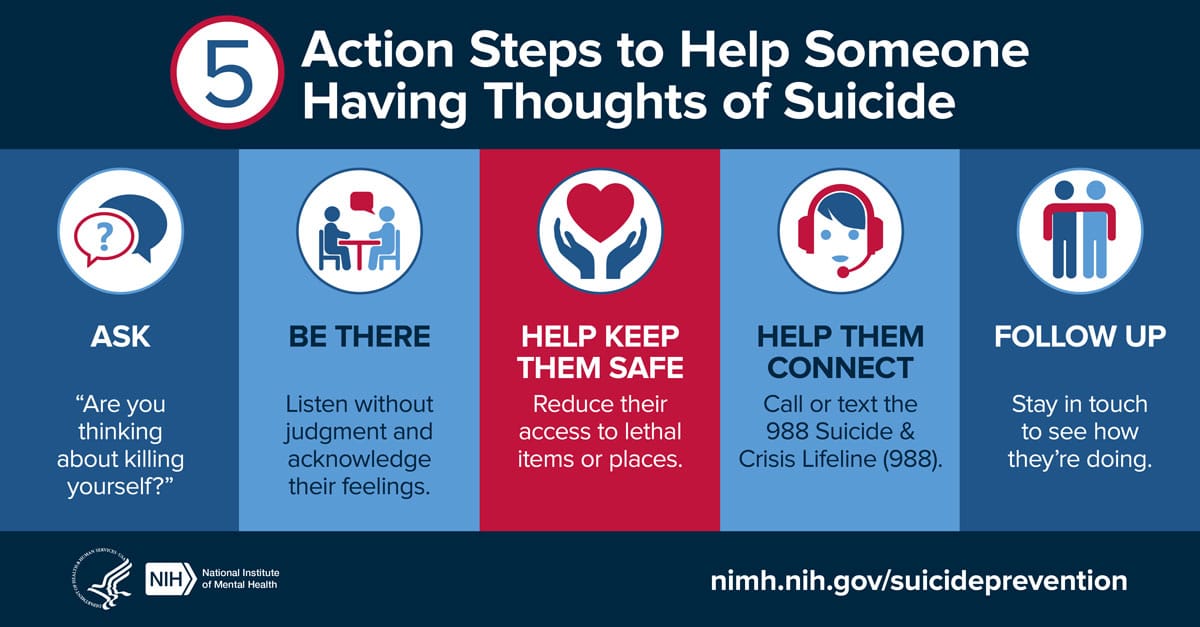
This September's Suicide Prevention Awareness Month is one of partial mourning for the lost national LGBT crisis hotline branch. It is also a time to celebrate and support the many services that continue to do the important work out here, helping our gay, trans, & queer loved ones survive.
If you are struggling with suicidal thoughts, know that your life is worthwhile, even if every part of your mind cruelly screams the opposite. I say this as someone who has survived very dark moments of self-inflicted harm and suicidal ideation. Reach out for help. I promise you that life can & will get better.
If you are seeking to help someone in your life dealing with suicidal thoughts, keep calm and familiarize yourself with some crisis support resources. Just by virtue of your caring and attempting to do right, you will have already contributed greatly to the chances of that someone's survival. Listen. Be there for them. Find help. You aren't alone.
RESOURCES
LGBT National Hotline: 888-843-4564
For those under 25: 800-246-7743
For help coming out: 888-688-5428
Calling 988 remains available for general suicide and crisis help, even if specialized "Press 3" branches of the service have ended. Available 24/7 in English and Spanish. The veteran-specific branch, "Press 1", is thankfully still available.
For peer-support, phone, or chat services, gender diverse folks young & old are welcome to call Trans Lifeline at 877-565-8860; text THRIVE to 313-662-8209 to chat with someone via SMS text; or visit the LGBT National Help Center online chat to communicate with someone over the web. These resources are available for support beyond crisis. If you're feeling down, need a little help, or just want someone to talk to about LGBT+ stuff, these contacts welcome you.
The aforementioned Trevor Project is available at 866-488-7386, or text 'START' to 678-678
SAGE LGBT Elder Hotline: 877-360-LGBT
It Gets Better: 888-843-4564
Blackline prioritizes serving the mental health needs of BIPOC communities. Call or text 800-604-5841
National Runaway Safeline: 800-786-2929
HIV/AIDS CDC Info Line: 800-232-4636
Desi LGBTQ+ Helpline (prioritizing South Asian American communities): 908-367-3374
LGBT near me is a program of the LGBT national help center and it can help connect you to resources local to you, including LGBT+ literate therapists
Drop-in counseling services are available at NAGLY (North Shore Alliance of LGBTQIA+ Youth in Salem, MA) and can be used without insurance. Contact tony@nagly.org for details
